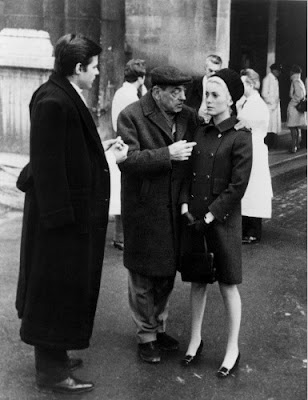.
Mrs. Tree's Sitting Room at Ditchley
Nancy Lancaster stated
" I was always searching for beauty wherever I've lived, wherever I've gone. I wasn't interested in the houses as I was in their ambiance. In the furniture, in the history, in the garden. You never really could put your finger specifically on whatever created beauty-it was too elusive-but house were where I found it the most." In all of her homes she found it-Haseley Court, Kelmarsh Hall and likely her most triumphant Ditchley. In 1933-Ditchley became Nancy's- her husband-long fascinated with Ditchley purchased the property. It is fascinating to note- the house was filled with furniture collected for over 350 years. After some of the important and stellar pieces were tagged to go along with the sellers-leaving the rest to the Trees, Nancy shrewdly drew the line, telling her husband
"we buy the house with everything or completely empty: one or the other, it was their choice. In the end they decided to sell it lock ,stock and barrel."Nancy during her Ditchley Reign photographed by Cecil Beaton
Serebriakoff painting
During Nancy's tenure at Ditchley- the room once referred to as the Tapestry Room became Mrs. Tree's Sitting Room. Here she attended to the daily business of running the house. The most important design element in the room was the exotic Chinoiserie Rococo carvings. Assisted by Stephane Boudin of Jansen in Paris, Mrs. Tree used him more as "contractor" and not decorator. She had no intention of creating a decorator's room- but a room of her own. The results were decidedly feminine, pale yellows, golds, whites and pinks for color and an 18th century Axminster carpet with birds, bouquets of flowers and wheat sheaths. Her design for the curtains-an elaborate Chippendale to do with pelmets- was loathed by Boudin-but Mrs. Tree insisted. The walls were covered in bleached out red Victorian damask, giving it a "sort of hardly pink color." A grand bureau plat with Austrian fauteuil, various pieces of black lacquer rounded out the room's design and lastly Nancy's witty addition of a oyster coloured felt embroidered table skirt with animals dressed in 18th & 19th century costumes- including Madame de Pompadour dressed with a goat's head.

The work was embroidered from the artist J J Grandville's drawings
LES SCENES DE LA VIE PRIVEE ET PUBLIQUE DES ANIMAUX published in 1842. The satirical caricatures drawn by Grandville provide an insightful commentary on society using animals- The inclusion of the table in Nancy's room at Ditchley and subsequently reappearing in her Saloon at Haseley Court in 1954 says a great deal about Lancaster's ideas about the bon ton. The Grandville embroiderys also tell us Nancy Lancaster got it right the first time-continually using her favourites, recycling pieces she loved and reinventing them in new settings. The Saloon-considered the most formal of the house again became an eclectic mix: girandoles from Ditchley (appearing in the first photograph above), aquamarine silk walls and a pair of aquamarine curtains that hung in the blue drawing room at Ditchley-being remade for Haseley. Nancy acquired the large Elizabethan paintings of the sisters Fitton for the Saloon at Haseley. Once again these reappear in Nancy's future homes and are now owned by Annette and Oscar de la Renta.

scenes from the Saloon at Haseley Court
Grandville's Scenes
Imagine my surprise when recently perusing forgotten books- I found in The Englishwoman's House, photographs of Anne and Michael Tree's Shute House-the same embroidered table skirt. Anne Tree "inherited" the whimsical piece from her mother in law Nancy Lancaster and placed it in her drawing room- referring to it as a "winner." Not too shabby- those hand me downs. "My husband was lucky to inherit a lot of furniture and carpets from his parents and over the years his mother has given us endless presents of beautiful things." Along with all the beautiful things inherited-also a pair of Ditchley bedroom curtains mentioned by Madame de la Tour du Pin in her diary written while residing with her relations at Ditchley after she fled the French Revolution.
the embroidered skirt in Anne Tree's drawing room
detail of Anne Tree's tablescape
Anne Tree had no plans to redo the house in future-obviously believing like her famous mother in law the only three essential ingredients for a successful interior-" a wood fire, candlelight and cut flowers." - and a table skirt.
suggested reading- the wonderful biography Nancy Lancaster Her life, her World, Her Art by Robert Becker, read about her life with many accounts of her world in her own words.
Nancy Lancaster English Country House Style by Martin Wood.
The Englishwoman's House edited by Alvilde Lees Milne
all photographs from one of the above books.
Madame de la Tour du Pin
here.
 Black patent Pilgrim shoe by Roger Vivier, with a platform and 4 ½” heel. Buckle is embroidered with “God Save the Queen” and R.V., $1125.
Black patent Pilgrim shoe by Roger Vivier, with a platform and 4 ½” heel. Buckle is embroidered with “God Save the Queen” and R.V., $1125. The Pilgrim shoe was first recontextualized when Catherine Deneuve wore the original Roger Vivier design in her role as a prostitute in Belle du Jour. Today's version has a platform and an almost 5" heel, so the sinfulness is built right into the shoe. Leave it to RV, to once again play with the Pilgrims by invoking allegiance to the very monarchy whose rule they fled.
The Pilgrim shoe was first recontextualized when Catherine Deneuve wore the original Roger Vivier design in her role as a prostitute in Belle du Jour. Today's version has a platform and an almost 5" heel, so the sinfulness is built right into the shoe. Leave it to RV, to once again play with the Pilgrims by invoking allegiance to the very monarchy whose rule they fled.



 &
&
